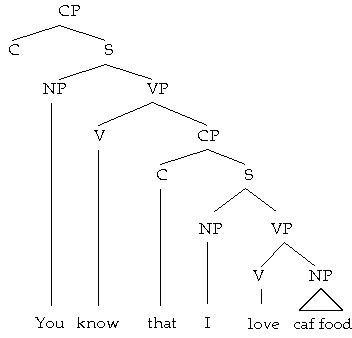- P(hrase) S(tructures) comprise
- CATEGORIES (NP, VP, AP, maybe PP) and
- their CONSTITUENTS. For example,
the book that I have is an NP of which
the book and that I have are constituents
but not *book that or *that I.
- The purpose of PS-rules.
- to represent formally the relationships of the miminal meaningful elements of phrases
- in hopes of discovering
- the mental operations involved in uttering sentences and
- the relation between formal and semantic structures.
- Phrase Structure Rules
- The structure of all phrases in all languages seems to reduce to
a single set of relations which hold for all categories:
Universal Structure of All Phrases XP > Spec + X' (X' > AP + X') optional X' > X + Comp
- Assuming P(reposition) is a category, the English phrase structure
grammar would look something like this:
A Phrase-Structure Grammar of English (1) CP > C + S ADJUNCT RULES (2) S > NP + VP (3) VP > Aux + V' (a) (X' > AP/PP + X') (4) V' > V (NP) (PP) (AP) (CP) (b) AP > Deg + A' (5) NP > Det + N' (c) A' > A (NP?) (PP) (CP) (6) N' > N (NP) (PP) (CP) (7) PP > Deg + P' (8) P' > P (NP) (PP) (CP)
- The structure of all phrases in all languages seems to reduce to
a single set of relations which hold for all categories:
- Bracketing (where "S" = "sentence," "clause," or "phrase")
- S(entence)[I love caf food]S(entence)
[you know that [I love caf food]S]S
[I know that [you know that [I love caf food]S]S]S - Full bracketing scheme
S[ NP[I] VP[ V[love[NPcaf food] ] ]
- S(entence)[I love caf food]S(entence)
- P(hrase) S(tructure) Trees
Phrases are held together by a complementizer phrase, [CPs] (not to be confused with complement phrases) as illustrated in the following diagram of a verbal complement.

Where CP = Complementizer Phrase, NP = "noun phrase", VP ="verb phrase", C = "complementizer", V, N, P, A ="verb, noun, preposition, and adjective".